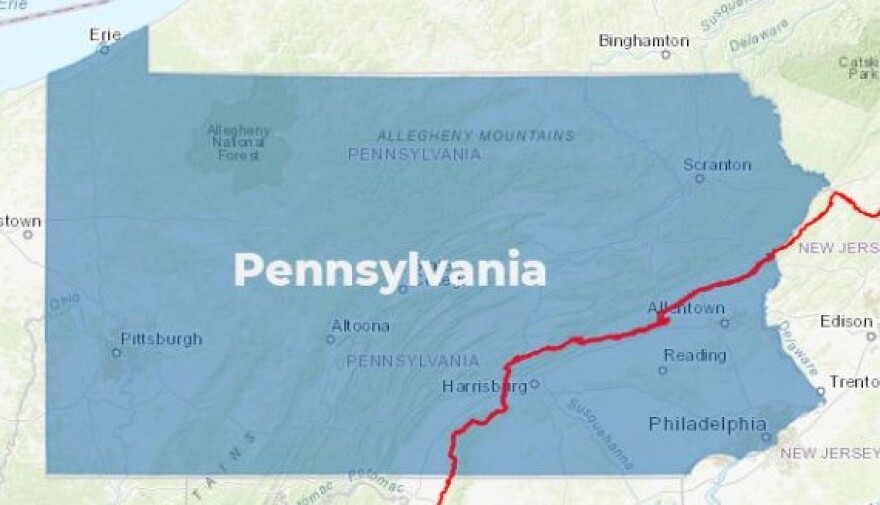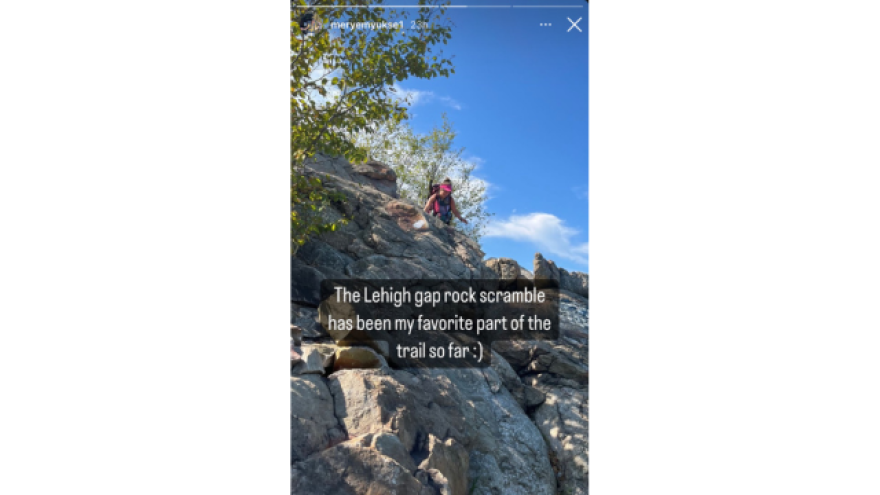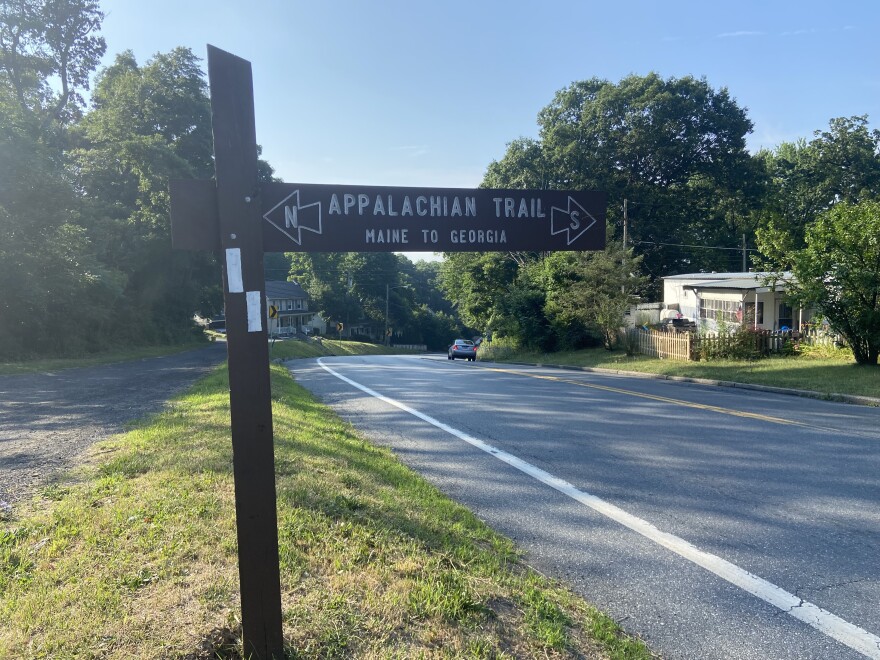ROSS TWP., Pa. — On her eighty-first morning thru-hiking the Appalachian Trail, Meryem Yuksel woke up in a tent she pitched in front of a motel, just over a quarter of a mile from the Wind Gap trailhead.
She didn’t sleep well the Monday night, camping near Route 115 traffic, and successive days of extreme heat were wearing on her. But, she was still motivated, closing in on completing 1,300 miles with 900 more to go.
“The heat has slowed me down,” Yuksel said while gathering her supplies and preparing for the next leg of the trek. “The highest I remember was 96 [degrees], and I was in Virginia.
“They call it the ‘Virginia Roller Coaster,’ where you go up and down,” she continued, motioning with her whole arm. “I was really stubborn about getting to the 1,000 mile mark that day. I remember I did above 20 miles that day in the heat, just because I really wanted to get to the 1,000 mile mark that day.”
For almost a century, hikers have visited the Appalachian Trail, the world’s longest hiking-only footpath. The reasoning varies, from recreation to reconnecting with nature and even as a meditation to discover the next move during a point of transition in life. A small portion of those, like Yuksel, take on the challenge to hike the entire trail, which winds up most of the east coast.
While physically and mentally challenging, thru-hiking the Appalachian Trail is also an opportunity, hikers said during a recent stop in the Lehigh Valley, to learn their physical and mental limits while gaining community all at the same time.
“All the community I’ve met — that’s been the biggest highlight."Meryem Yuksel
“All the community I’ve met — that’s been the biggest highlight,” Yuksel said. She’s been vlogging her experience thru-hiking, posting updates daily to her Instagram page.
“There were many trail angels along the way, who offered their place to thru-hikers,” she said. “There have been people who say, ‘When you get nearby, I can help you out.’
“And there was even a lady just a week ago. She reached out on social media and said, ‘I opened my house to thru-hikers. You can stay here.’”
That community extends both on and off the trail. Hikers often take trail names, and even join “tramilies,” or trail-families, along the way. Yuksel, a 22-year-old from Orlando, Fla., was nicknamed “Sigma” after a Gen Z meme she couldn’t stop repeating.
At the Gateway Motel, 213 Emerson Road, a handful of thru-hikers were camped for the night before continuing on to the next leg, from Wind Gap to Delaware Water Gap, where hikers cross over the Delaware River and into New Jersey.
They included Kentucky, a 22-year-old nicknamed for her home state, and Detour, a thru-hiker originally from Rhode Island who most recently lived in Connecticut.
“I decided I didn't want to live there anymore,” Detour said. “I basically got rid of everything. I was making a life change anyway.
“I figured while I'm in the middle of a life change, which a lot of people are out here, it’s the perfect time to hike the trail.”
It’s thru-hiker season on the Appalachian Trail! I spent my morning talking to some amazing hikers, all with trail nicknames.
— Molly Bilinski, artisanal sentence crafter (@MollyBilinski) July 9, 2024
Sigma, Detour and Kentucky, it was a pleasure meeting you and hearing your stories!! Happy hiking!!
Keep an eye out for the story at @LVNewsdotcom 👀 pic.twitter.com/ardw599oUC
‘Climbing Mt. Everest 16 times’
The Appalachian Trail is 2,197.4 miles — one mile shorter than last year due to footpath relocations — stretching from its northern terminus at Springer Mountain in Georgia's Chattahoochee-Oconee National Forest to its southern terminus, the summit of Katahdin in Maine's Baxter State Park.
Completed in 1937, it’s the longest hiking-only footpath in the world, drawing hikers from all over.
“Known as the ‘A.T.,’ more than 3 million people visit the trail every year and over 3,000 people attempt to ‘thru-hike’ the entire footpath in a single year,” according to the nonprofit Appalachian Trail Conservancy, or ATC. “People from across the globe are drawn to the A.T. for a variety of reasons, such as reconnecting with nature, escaping the stress of city life, meeting new people or deepening old friendships, or experiencing a simpler life.”
It takes roughly six months and 5 million steps to hike the entire trail, passing through six National Park Service units, eight national forests and two wildlife refuges, according to the conservancy. When thru-hiking, the total elevation gain is equivalent to climbing Mt. Everest 16 times.
The AT stretches for just more than 230 miles through Pennsylvania’s farmland, mountains and valleys, and is home to the trail’s halfway mark. Hikers call the Commonwealth “Rocksylvania” because of the rocky terrain.

The trail’s midway point is at Pine Grove Furnace State Park in Gardners, Adams County, and is also the location of the Appalachian Trail Museum. There, thru-hikers — including Sigma — take part in the “half gallon challenge,” consuming a half gallon of ice cream to celebrate their progress.
There are three municipalities marked as Appalachian Trail Communities throughout the state, including Boiling Springs in South Middleton Township, Cumberland County; Duncannon, Perry County; and Wind Gap, Northampton County.
The Lehigh Valley borough was named an Appalachian Trail Community in 2015 for its care for AT hikers, as well as officials’ pledge to support, protect and promote the trail.
“The Appalachian Trail Conservancy is proud to celebrate Wind Gap as an AT Community partner in Pennsylvania that is helping to protect and promote the Appalachian Trail,” said Julie Judkins, the ATC’s director of education and outreach, in a news release at the time. “These new partnerships increase local stewardship of public lands, support community initiatives for sustainable economic development and conservation planning and support healthy lifestyles for community citizens."
‘To try something, get outside’
Most thru-hikers walk north, starting in Georgia in spring and finishing in Maine in fall, taking an average of six months. However, the statistics for success are grim — only about one in four people who attempt to thru-hike the AT actually complete it.
Sigma started hiking on April 20 in Georgia after putting in less than a year of prep work, mainly collecting supplies. She had just graduated college when she decided to take the hike, working for three months at one job before switching to substitute teaching to save up.
“I started working, and I wasn't very happy with my job, because I studied computers before this and I was working at a desk,” she said. “I was like, ‘I want to try something, get outside.’ And I was like, ‘I'm gonna do that. I'll do the Appalachian Trail.’”
Asked if she physically prepared by completing section or day hikes, she shook her head and laughed before adding that, before this hike, the longest she spent in the woods at once was four days.
“I would say most people don’t physically prepare,” Kentucky said as she slathered peanut butter on a soft shell tortilla and added crushed up chocolate cookies, proudly displaying her “thru-hiker breakfast.” “But some people do — I did. I physically prepared specifically to do it.
“So then, I was able to start out fast. A lot of people have to start slow, but I was able to do 20 miles [per day] from the beginning.”
Sigma started at about 10 miles a day, starting slowly to lessen the chance of injury.
“Then I upped it to 12 [miles] the next week or so, and then I was going around 15 for a couple more weeks and then 18 and 20 because the terrain also got a bit easier in Virginia,” she said. “They say it's easier in the mid-Atlantic, but it's really rocky in northern Pennsylvania, so I would say it's not. These days, I'm doing 18 or 19 [miles on] average.”
She plans to complete the trail before the northern terminus closes in early or mid-October due to snow.
As for her experiences so far on the trail, Sigma said hiking Lehigh Gap was a highlight.
“I really like climbing that, because Pennsylvania hasn't been my favorite because it’s so flat and rocky,” she said. “You feel like you can go fast, but the rocks are holding you back – it's just kind of a bummer.
“But then, Lehigh Gap was really nice because you got to climb — it felt kind of epic.”

‘It's a mental game’
Thru-hiking the Appalachian Trail isn’t just a walk in the woods. There are plenty of hazards parallel to the natural beauty, from lack of shelter or freshwater, sickness, extreme weather and wild animals.
“I did see two black bears so far,” Sigma said. “The first time I saw one, it just bolted away from me, which I thought was kind of funny because I'm half the bear’s size and it’s just running away from me.
“And then the second time the same thing happened.”
Norovirus is also a concern on the trail, where handwashing and clean water supplies can be few and far between. The sickness is highly contagious and can cause vomiting and diarrhea.
“All the springs have dried up from Palmerton to here,” Sigma said, adding hikers have been relying on locals who set up water caches for hikers, free of charge. Hikers refer to these helpful gestures as “trail magic.”
But, aside from the external threats, the last leg of the thru-hike takes emotional fortitude, hikers said.
“It's a mental game from here on out,” said Detour as he started packing up camp at the motel. “We all have the cardiovascular endurance. We can make it physically.
“Now, it's a mental game.”
The hike is grueling the entire way through, and hikers can burn up to 6,000 calories a day, according to the conservancy.
“If you ever feel like quitting, I'd say to somebody that maybe they're taking it too hard,” Sigma added. “Sometimes we will take it too hard — you can slow down.”
Detour’s advice? Never quit on a bad day.
“If you're having a bad day, and you need a mental reset, take a day off, go get a hot shower, do your laundry,” he said. “Feel like a human again. It's a big difference just getting clean — just getting out of the woods.”

During the hour-long conversation, Sigma, Detour and Kentucky sat at a picnic table, swapping stories, experiences and the names of other hikers they had met along the way. None of them had met before the trail.
“When you’re thru-hiking, you become part of a community,” Sigma said. “It’s like a walking city. It's just a whole different experience than a weekend backpacking trip.”


